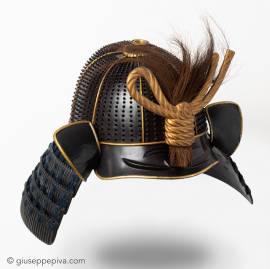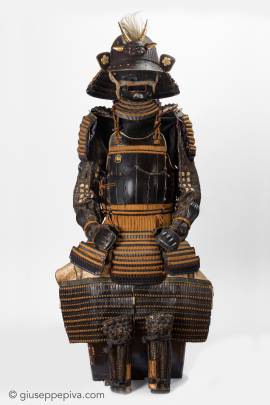Mid Edo Period, 18th Century Rare eight-plate kabuto with seven rows of twenty-five rivets each for a total of 1,400, which get smaller as they get closer to the peak of the helmet. The plates' edges and the profiles of the visor and fukigaeshi are covered in golden brass, with a six-tier tehen no kanamono of various metals and colors at the top. Eyebrows and wrinkles are embossed on the visor (mabisashi). The komanju shikoro is uncommon, with five kiritsuke-kozane plates and a sugake-odoshi binding, which is rarely connected with this style.
WORKS FOR SALE
Samurai armor with a stylised torso designEarly to mid Edo period, 18th century The unique construction of this authentic samurai armor is made to resemble the nude torso of a Buddhist guardian deity, Niō. In fact, the front section is composed by six shaped plates, not including the top one, that outline the design of breast muscles. This kind of design, in a very naturalistic render rather than stylized as in this case, was popular among samurai since the Momoyama period and some famous suits of armor are embossed as a nude torso.The helmet is a Haruta school 50 plates sujibachi...
Cartwheels and foxLate Muromachi Period (1336-1573)Exhibition:"Samurai - Passato e presente", Novara 2012 Literature:G.Piva - S. Verrina, Samurai - Passato e Presente, cat. A13, Novara, 2012Iron with brass hira-zoganDiameter: 82 mmThickness: 4 mmAn excellent ubu example of Kaga Yoshiro work from the Muromachi period. Very dense iron with good tekkotsu, not factory plate. All the inlay is intact. At the time that this was made, brass was an extremely valuable commodity in Japan, rivaling gold, as it was imported from China. The shape is a ...
Copyright © 2016 - giuseppe piva - VAT: 05104180962










